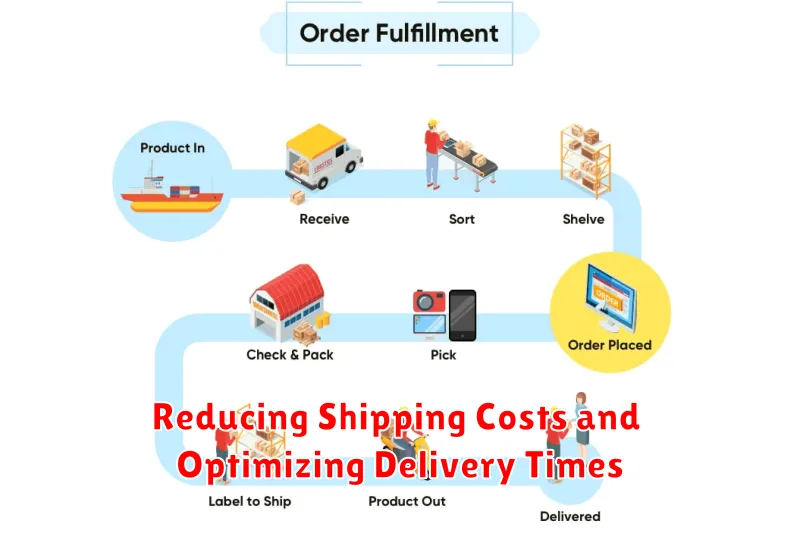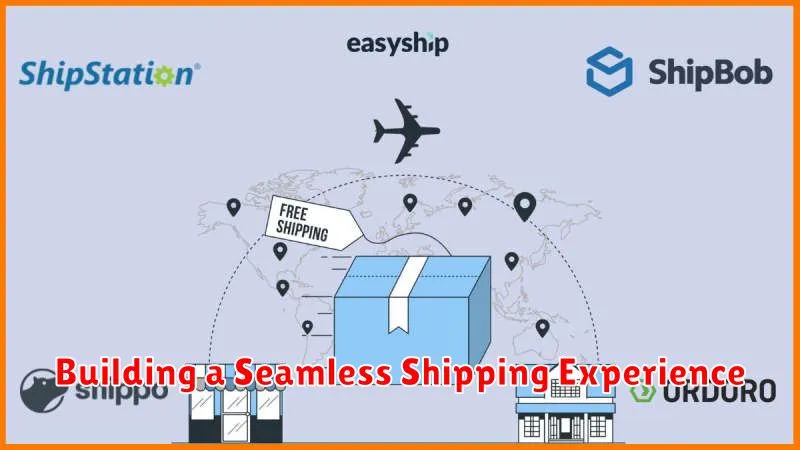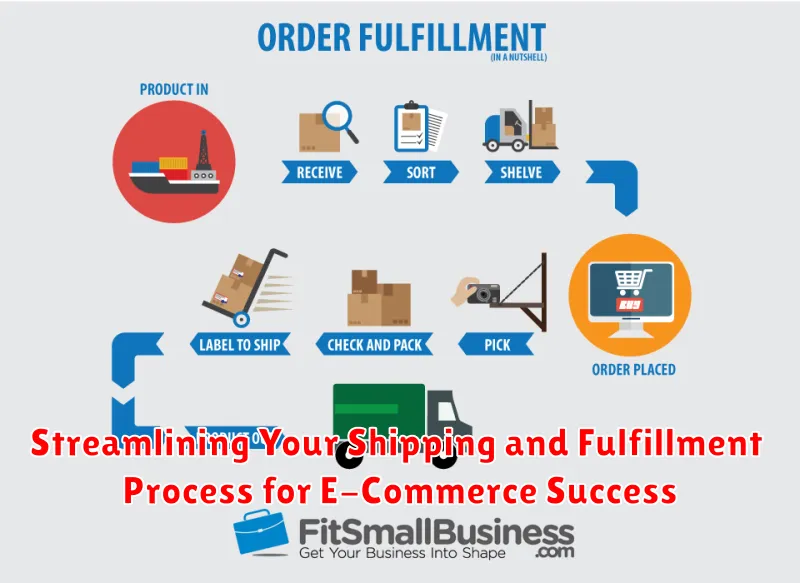In today’s competitive e-commerce landscape, a streamlined shipping and fulfillment process is crucial for success. Customers expect fast, reliable, and affordable delivery, and failing to meet these expectations can significantly impact your bottom line. This article will explore key strategies to optimize your shipping and fulfillment operations, ensuring a seamless experience for your customers and driving growth for your business. We will delve into the importance of efficient order fulfillment, inventory management, and choosing the right shipping solutions to maximize efficiency and minimize costs. Learn how to transform your shipping and fulfillment process into a competitive advantage.
From warehouse organization and inventory management to selecting shipping carriers and implementing order tracking systems, this comprehensive guide will provide practical insights and actionable steps to streamline your shipping and fulfillment. Discover how to reduce shipping costs, improve delivery times, and enhance customer satisfaction, ultimately boosting your e-commerce success. Whether you are a startup or an established business, optimizing your e-commerce shipping and fulfillment is essential for sustained growth and profitability.
Understanding the Importance of Efficient Shipping
In today’s competitive e-commerce landscape, efficient shipping is paramount to success. It directly impacts customer satisfaction, brand reputation, and ultimately, your bottom line. Fast and reliable shipping is no longer a luxury, but an expectation.
Delays, damages, and inaccurate deliveries can lead to negative reviews, lost customers, and increased operational costs. A streamlined shipping process, on the other hand, fosters trust and loyalty. Customers are more likely to return to businesses that provide a positive delivery experience.
Efficient shipping also plays a crucial role in cost control. Optimizing your shipping strategies can significantly reduce expenses related to packaging, carrier fees, and labor. This allows you to offer competitive shipping rates to customers while maintaining healthy profit margins.
Choosing the Right Shipping Methods for Your Business
Selecting the right shipping methods is crucial for balancing customer satisfaction and profitability. Several factors influence this decision, including the types of products sold, target audience expectations, and budget.
Product characteristics like weight, size, and fragility dictate suitable shipping options. Heavy or bulky items might necessitate freight shipping, while smaller, less fragile items can be shipped via standard carriers.
Customer expectations play a significant role. Offering various shipping speeds, from express to economy, allows customers to choose based on their needs and budget. Free or discounted shipping can also be a powerful incentive.
Your budget will heavily influence shipping choices. Negotiating rates with carriers, using shipping software to find the best deals, and optimizing packaging can help control costs.
Consider offering a mix of shipping options, such as flat-rate, real-time carrier calculated, and free shipping thresholds. This provides flexibility for both your business and your customers.
Inventory Management Best Practices
Effective inventory management is crucial for seamless order fulfillment. Overstocking ties up capital and risks obsolescence, while understocking leads to lost sales and disappointed customers. Implementing best practices ensures optimal stock levels.
Demand forecasting plays a vital role. Analyze historical sales data, seasonality, and market trends to predict future demand accurately. This informs purchasing decisions and minimizes the risk of stockouts or overstock situations.
Utilize a robust inventory management system. Software solutions provide real-time visibility into stock levels, automate reordering processes, and track inventory across multiple locations. This streamlines operations and reduces manual errors.
The First-In, First-Out (FIFO) method is a best practice for perishable or time-sensitive goods. This ensures older inventory is shipped first, reducing the risk of spoilage or obsolescence.
Regular cycle counting verifies physical inventory against recorded quantities. This identifies discrepancies and helps maintain accurate stock data. Address discrepancies promptly to prevent inventory errors from impacting order fulfillment.
Order Fulfillment Strategies: In-House vs. Outsourcing
Choosing between in-house and outsourced fulfillment is a crucial decision for e-commerce businesses. Both models offer distinct advantages and disadvantages that need careful consideration.
In-house fulfillment offers greater control over the entire process. You directly manage inventory, packaging, and shipping. This allows for tight quality control and potential cost savings for high-volume businesses. However, it requires significant upfront investment in warehouse space, equipment, and personnel.
Outsourcing fulfillment, often through a third-party logistics (3PL) provider, frees you from the operational burden of warehousing and shipping. 3PLs handle everything from storage and picking to packing and shipping, allowing you to focus on other core business aspects. Outsourcing is often more scalable and cost-effective for smaller businesses or those experiencing rapid growth, but relinquishes some control over the customer experience.
The best approach depends on factors such as order volume, business growth projections, budget, and the level of control desired over the fulfillment process. Carefully weigh these factors to make the best decision for your business.
Automating Your Shipping and Fulfillment Process
Automation plays a crucial role in optimizing e-commerce shipping and fulfillment. By automating key processes, businesses can significantly reduce manual effort, minimize errors, and improve overall efficiency. This leads to faster processing times, reduced costs, and increased customer satisfaction.
Several areas within shipping and fulfillment benefit from automation. Order processing can be automated by integrating your e-commerce platform with your inventory and shipping systems. This allows for automatic order entry, inventory updates, and label generation. Shipping label creation can be streamlined with software that automatically generates labels with the correct shipping information and postage.
Inventory management automation helps maintain accurate stock levels, predict demand, and automate reordering. Automated email notifications can keep customers informed about their order status, shipping updates, and delivery confirmations. Lastly, consider automating reporting and analytics to track key metrics, identify areas for improvement, and make data-driven decisions about your shipping and fulfillment strategy.
Tracking Shipments in Real-Time for Customer Satisfaction
In today’s fast-paced e-commerce landscape, customers expect transparency and control over their orders. Real-time shipment tracking is no longer a luxury but a necessity for ensuring customer satisfaction.
Providing real-time tracking updates empowers customers to monitor their package’s journey from warehouse to doorstep. This visibility reduces anxiety and uncertainty, leading to a more positive post-purchase experience.
Benefits of real-time tracking:
- Reduced customer inquiries about order status.
- Proactive communication about potential delays.
- Increased customer trust and loyalty.
- Improved delivery management for both customers and businesses.
By integrating a robust tracking system into your e-commerce platform, you can enhance the overall customer experience and build stronger relationships with your buyers.
Reducing Shipping Costs and Optimizing Delivery Times

Negotiating shipping rates with carriers is crucial for reducing costs. Volume discounts and establishing strong carrier relationships can significantly impact your bottom line. Consider consolidating shipments where possible to minimize individual package expenses.
Packaging optimization plays a vital role in both cost reduction and delivery efficiency. Analyze your packaging materials and practices. Using appropriately sized packaging minimizes dimensional weight charges and reduces material costs. Explore sustainable packaging options to further enhance cost savings and brand image.
Strategic warehouse locations can dramatically optimize delivery times and reduce shipping costs. Distributing inventory across multiple fulfillment centers closer to your customer base minimizes transit distances and can unlock faster, more affordable shipping options like regional carriers.
Handling Returns and Exchanges Effectively
A streamlined returns and exchanges process is crucial for customer satisfaction and operational efficiency. Clearly defined policies are the foundation. Ensure your return policy is easy to understand and readily accessible on your website.
Provide multiple return options. Offering choices such as pre-paid return labels, drop-off locations, or in-store returns (if applicable) enhances convenience for customers. This flexibility can significantly improve the customer experience, even in the unfortunate event of a return.
Automate the process. Utilize a returns management system to automate communications, track returned items, and process refunds or exchanges quickly. Prompt processing builds trust and minimizes customer frustration.
Analyze return data. Identify trends in returns and exchanges to understand the root causes. This data can inform improvements in product quality, packaging, or even product descriptions, ultimately reducing future returns.
Key Metrics for Measuring Shipping and Fulfillment Performance
Monitoring key performance indicators (KPIs) is crucial for understanding the effectiveness of your shipping and fulfillment process. Tracking these metrics allows you to identify areas for improvement and optimize for greater efficiency and customer satisfaction.
Order fulfillment rate measures the percentage of orders processed and shipped successfully. A high rate indicates efficient operations.
On-time shipping rate tracks the percentage of orders shipped within the promised timeframe. This metric directly impacts customer satisfaction.
Shipping cost per order helps assess the overall cost-effectiveness of your shipping strategy. Lowering this cost without sacrificing speed is key.
Order accuracy rate measures how many orders are shipped correctly without errors like incorrect items or quantities. Maintaining a high accuracy rate minimizes returns and boosts customer confidence.
Customer order cycle time measures the time elapsed from when a customer places an order to when they receive it. A shorter cycle time contributes to a positive customer experience.
Return rate indicates the percentage of orders that are returned. Analyzing return reasons can help identify issues with products, shipping, or the ordering process.
Building a Seamless Shipping Experience

A seamless shipping experience is crucial for customer satisfaction and retention. It involves streamlining every step of the shipping process, from the moment an order is placed to its final delivery. This creates a positive impression and encourages repeat business.
Clear communication is key. Customers should receive regular updates regarding their order status, including shipping confirmations, tracking information, and estimated delivery dates. Proactive communication about potential delays can mitigate frustration and manage expectations.
Offering multiple shipping options caters to diverse customer needs and preferences. Providing choices like express shipping, standard delivery, and even pick-up locations empowers customers and enhances flexibility. Clearly displaying the cost and estimated delivery time for each option promotes transparency.
Simple returns and exchanges are essential components of a positive shipping experience. A hassle-free return process, including prepaid return labels and clear instructions, can significantly improve customer satisfaction. A straightforward exchange policy can also build trust and loyalty.

